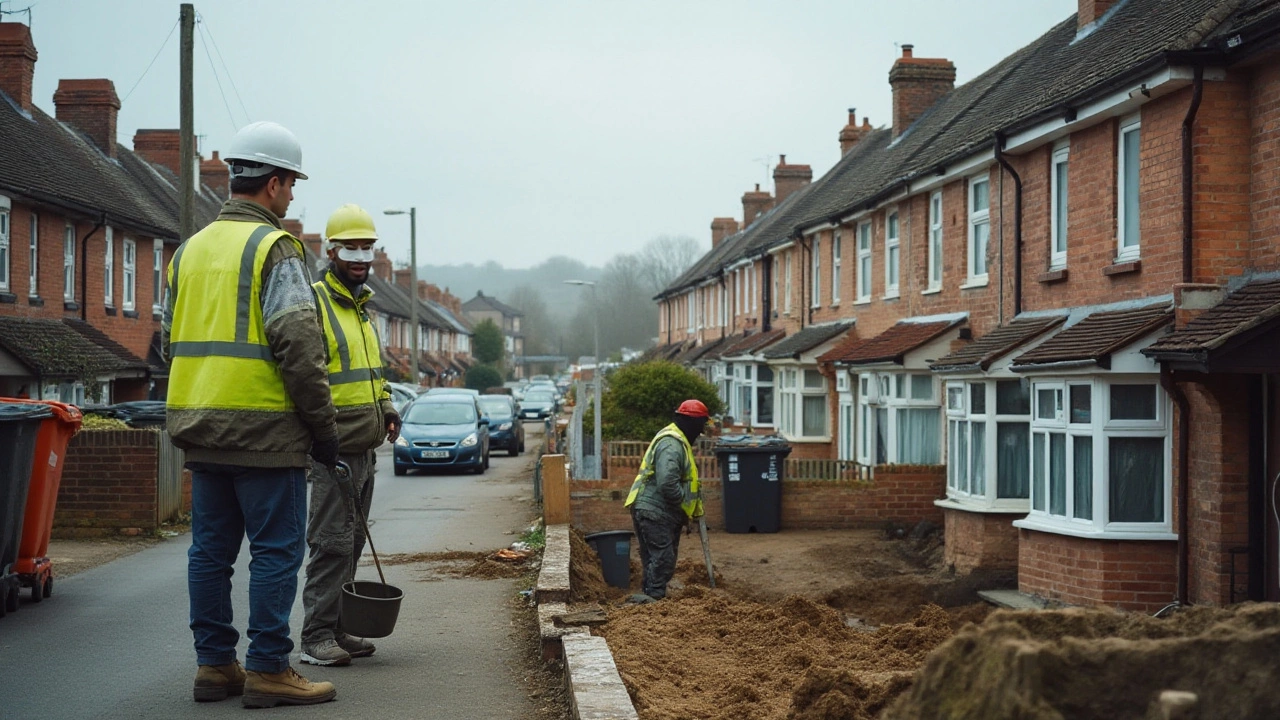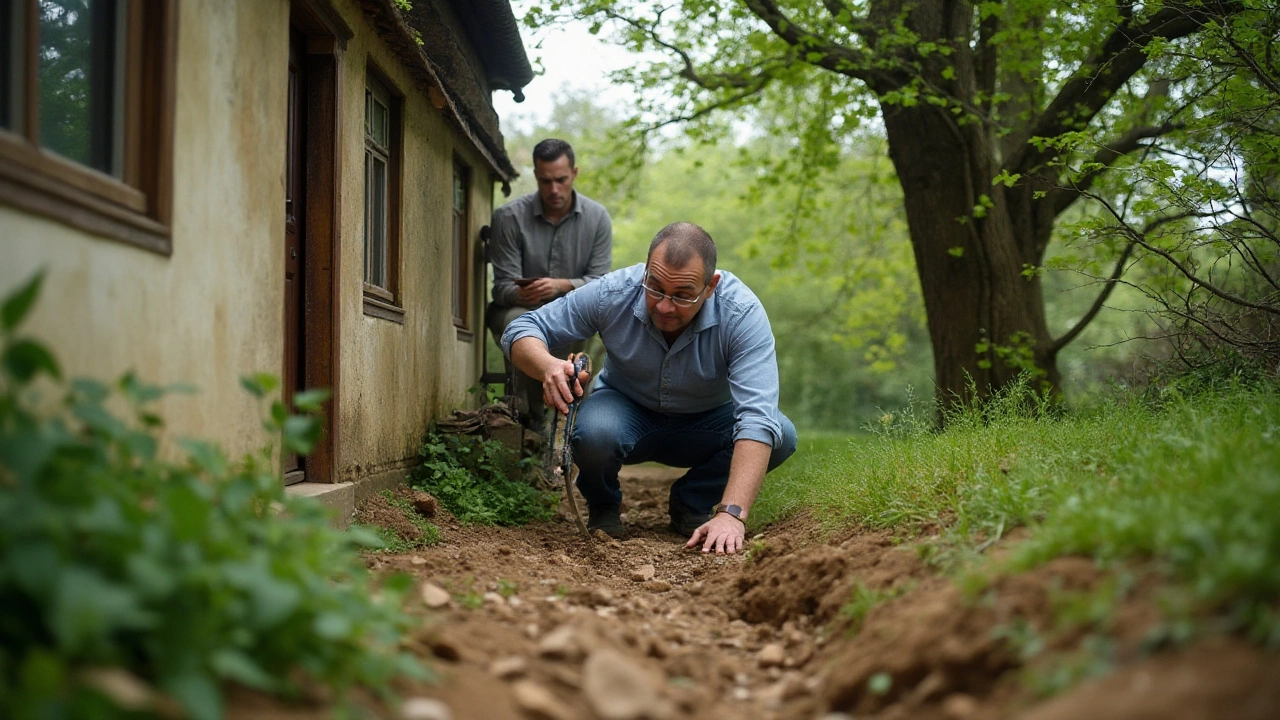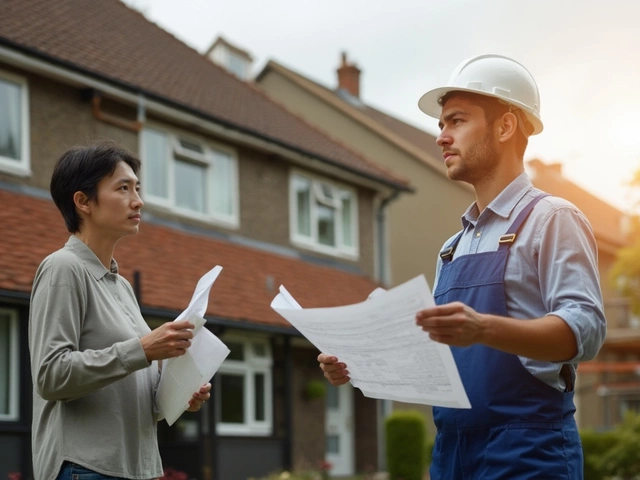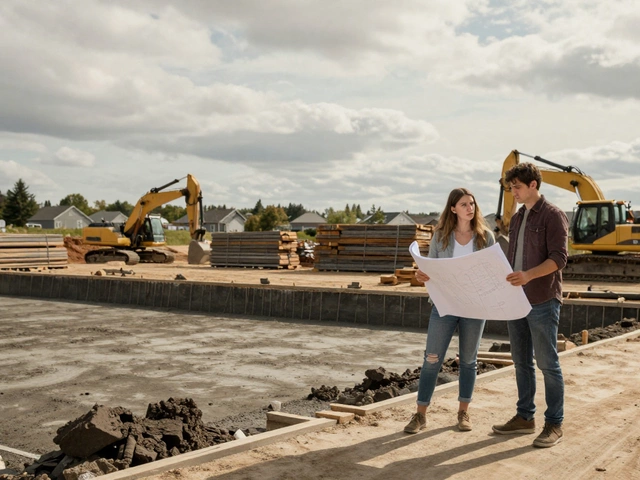When a home's foundation starts showing signs of wear, homeowners often face a tough choice: is it worth investing in repairs? The foundation is crucial, supporting the entire structure above. Though this might seem like an obvious reason to act quickly, the costs and complexities can make the decision more difficult.
Let's explore the various aspects of foundation repairs, shedding light on why they matter, what to expect, and how to make informed choices. From signs of damage to preventative measures, understanding how to manage your foundation can save you more than just dollars—it can secure your family's safety and peace of mind.
- Understanding Foundation Issues
- Common Causes of Foundation Damage
- Costs and Financial Considerations
- The Long-term Benefits of Repairs
- DIY vs. Professional Foundation Repair
- Preventative Measures to Avoid Future Issues
Understanding Foundation Issues
Foundations are the bedrock of a property, both literally and metaphorically. They uphold everything from the walls to the roof, ensuring that the structure remains level and intact. It begins with the soil the house is built on, which plays a pivotal role in the health of your home's foundation. Different soil types, like clay or sand, expand and contract with moisture, causing shifts that may lead to cracks or even significant structural issues. Environmental changes such as droughts or heavy rains can exacerbate these problems. Thus, knowing the type of soil beneath your home is the first step in understanding foundation issues.
Foundation problems can manifest in various ways. You might notice cracks in the walls or a door that stubbornly resists closing. Often, these issues start small and insidiously, making it easy to overlook them until they've developed into major headaches. Uneven floors can be a telltale sign, as the structure subtly shifts over time. These problems are not just cosmetic; they can threaten the integrity of the entire building. It's essential to remain vigilant and proactive when looking for signs of damage, as early detection can save a lot of trouble down the line.
Common Signs and Symptoms
To effectively combat foundation issues, it's crucial to recognize the symptoms. Cracks in floors and walls are the most obvious indicators, but not all cracks are created equal. Horizontal cracks might suggest water pressure or soil issues, while vertical ones can indicate settling. You might also experience a sticking door or window, uneven floors, or a leaning chimney. These symptoms should not be ignored. They are your home's way of waving a red flag. Other subtle signs might be moldings or trim pulling away from the walls due to shifting. Keeping an eye on these details can make the difference between a minor repair and a significant overhaul.
"The first law of homeowning is that everything is interconnected. The effects of a foundation problem rarely stop at the foundation itself," notes architectural expert, Lindsey Clark.
Indeed, foundational issues can ripple through other aspects of home maintenance. Addressing these issues requires a comprehensive understanding of what lies beneath and how it affects the building above. With such knowledge, homeowners can make informed decisions, ensuring safety and long-term savings.
Common Causes of Foundation Damage
Understanding the common causes of foundation damage is essential in preventing and tackling issues early on. A house foundation is meant to endure the forces of nature, yet certain factors might precipitate or expedite damages. One of the principal causes is the soil beneath the foundation itself. Expansive soils, rich in clay, can swell when wet and shrink when dry, creating a push-and-pull effect on foundations. Over time, this can lead to cracks, misalignment, and even foundation failure.
Another formidable enemy is water. Poor drainage systems or heavy rainfall can lead to water pooling around the base of your home. This excess moisture can cause soil erosion and compromise the structural integrity of your home. Many homeowners underestimate their landscape's natural drainage patterns, only to find out too late that natural water flow has undermined their foundation. Structural engineers often stress the importance of maintaining gutters and downspouts. As one expert put it, ‘Water is both friend and foe; it nourishes life yet can undermine the ground that supports our homes.’
Climate plays an undeniable role as well. Areas experiencing frequent freeze-thaw cycles see foundations wearing out more quickly due to repeated expansion and contraction from the cold, akin to a slow-motion jackhammer. Conversely, locations with intense drought periods can face the risk of foundations cracking as the parched soil contracts profoundly.
Tree roots are surprisingly tenacious factors in foundation damage. Growing invisibly beneath the surface, roots can reach far to quench their zealous thirst, drawing out essential moisture from the soil around the foundation. Over time, as the roots grow, they can exert significant pressure on the structure. It's not uncommon for gardeners to discover a beloved backyard oak has been secretly orchestrating foundational havoc!
Construction practices might bear a share of the blame too. Homes built with inferior materials or constructed on inadequately prepared sites often face frequent foundation problems. A foundation should represent security and permanence, yet one created without careful consideration could become a persistent headache. As such, ensuring qualified professionals carry out construction using the best materials is a preventive measure each homeowner should prioritize.
The International Association of Certified Home Inspectors points out, ‘Not all cracks are dangerous. Hairline cracks, small and non-threatening, are normal. But if your cracks seem to widen or new ones appear, it might be time to consult a specialist.’
Finally, natural disasters, although unpredictable, are significant catalysts for foundation damage. Earthquakes can instantly shift the soil, creating upheaval and disruption to even the sturdiest structures. While this is less controllable, living in such zones mandates periodic inspections to ensure early indicators of foundational stress are identified.

Costs and Financial Considerations
Repairing your home's foundation isn't just an architectural concern—it's a financial one too. When you first notice cracks or uneven floors, the looming question is: How much will it cost to resolve these issues? The cost of foundation repair can vary significantly, ranging from a few hundred dollars to tens of thousands, depending on the extent of the damage and the methods utilized. Typically, minor cracks might set you back a few hundred dollars, whereas more extensive repairs, involving lifting or stabilizing the home, could easily dip into the five-figure bracket.
The type of foundation your house has—be it concrete slab, pier and beam, or basement—also plays a critical role in determining costs. Concrete slabs are often more straightforward and less costly to repair than homes with basements, where water leaks or faulty drainage systems can lead to more complicated fixes. If we delve deeper, beyond the type of foundation, external elements like soil type, climate conditions, and additional water damage can complicate the repair process. For example, homes built on clay-rich soils may face more issues as these soils expand and contract with moisture, leading to uneven settling and cracks.
Additionally, local building codes and the cost of living in your geographical area can influence repair expenses. It’s crucial for homeowners to consider these factors when planning their budgets. Beyond the initial outlay, one must consider the longevity and quality of the work. Hiring inexperienced contractors might save money upfront, but shoddy workmanship could lead to higher costs in the future. As the renowned architect Frank Lloyd Wright once said,
"The bitterness of poor quality remains long after the sweetness of low price is forgotten."
To navigate this complex financial landscape, foresight and preparation are key. Consider obtaining multiple estimates from reputable contractors to understand the scope and scale of your specific problem. A detailed estimate should break down labor, materials, and potential hidden costs such as permits. Looking into financing options can also be a practical step; some companies may offer installment plans or connect homeowners with lenders who provide loans specifically for home repairs.
One practical consideration is the potential increase in property value post-repair. While the upfront costs might seem daunting, having a stable, secure foundation can significantly boost your home's resale value. Realtors often highlight the structural integrity of a home to potential buyers, making foundation repair a wise investment rather than an expense. This is particularly impactful in regions prone to issues like erosion or landslides, where buyers are mindful of past and future potential problems.
In sum, tackling foundation repairs demands a comprehensive understanding of both immediate costs and future financial benefits. By approaching the situation with thorough research, careful planning, and strategic investments in professional help, homeowners can make informed decisions that protect their most valuable asset—their home.
The Long-term Benefits of Repairs
The decision to invest in foundation repair is not just about addressing immediate defects; it's about securing a stable future for your home. A solid foundation is essential not only for maintaining structural integrity but also for safeguarding your property value. When foundations are repaired effectively, they can prevent a cascade of additional problems that can arise as a result of neglecting this critical element of your home. Cracks, uneven floors, and even problems like sticking doors and windows can often be traced back to foundation issues.
Ensuring your home's foundation is in top shape can help you avoid costly repairs in other areas of your house down the line. By fixing the root cause, you're effectively investing in a more predictable future when it comes to home maintenance and repair costs. A stable foundation can significantly reduce the likelihood of needing to replace other structural components. As a result, homeowners often find that the initial cost of foundation repair is offset by the savings and peace of mind gained over time.
"A stitch in time saves nine." Often attributed to Benjamin Franklin, this adage perfectly encapsulates the wisdom of addressing foundation issues early before they escalate into more serious conditions.
Aside from preventing future repairs, foundation repairs can also have aesthetic benefits. A home with fewer visible cracks and a more even appearance can inject pride into homeownership, not to mention the positive impression it leaves on prospective buyers. This is crucial if you're considering selling your home. Many buyers are wary of properties with foundation issues, and a repaired foundation increases marketability and potential resale value. It acts as a testament to the homeowner's diligence in maintaining the property.
Moreover, improved structural integrity translates to enhanced safety for everyone under your roof. Your family deserves a living environment that is free from risks associated with foundation problems, including the potential shift of the building. Stability isn't something that can be compromised, and in areas prone to natural events like earthquakes or floods, a robust foundation can make all the difference. In fact, a well-maintained foundation can act as a selling point in geographical areas known for unstable ground conditions or seismic activity, reassuring both insurers and prospective buyers alike.
In certain regions prone to extreme weather fluctuations, such as those experiencing harsh winters or hot and dry summers, a healthy foundation adds an additional layer of security. Seasonal changes can cause expansion and contraction in the ground, stressing your foundation over time. Regular inspection and proactive foundation repair can mitigate these risks, ensuring your home remains as insulated from adverse ground conditions as possible. Many homeowners have come to view foundation repair not just as an expense but as a long-term investment in their property's future.
An insightful statistic from a home study suggests that for every dollar spent on proactive foundation maintenance, homeowners save on average $5 in avoided costs of more severe repairs. Such statistics underscore a vital truth: while no homeowner relishes the prospect of foundation repair, the long-term benefits often prove far more substantial than the initial outlay. Prioritizing your foundation's health is ultimately an investment in peace of mind, safety, and your home's enduring value.

DIY vs. Professional Foundation Repair
Deciding whether to tackle foundation repair yourself or hire professionals is no small matter. Many homeowners, enamored by the prospect of saving money and gaining a sense of accomplishment, consider the DIY route. However, the complexity and seriousness of foundation issues can make this a daunting task. First, it's important to understand the types of foundation problems your home might have. Hairline cracks and minor surface issues might seem easy to address, but the underlying cause could be much more severe. Identifying these issues accurately often requires the trained eye of a professional.
A key consideration is the tools and materials needed. Professional foundation repair involves specialized equipment and expertise that most homeowners simply don't possess. Concrete piers, hydraulic jacks, and advanced leveling tools are standard in professional repairs. Attempting to use inadequate tools could lead to further damage and increased expenses. Moreover, the hidden costs of errors and rework could far exceed any savings initially anticipated by going it alone. Properly understanding the breadth of the work is critical to ensure structural safety and longevity.
Professional contractors bring a wealth of knowledge and experience to the project, which can be invaluable. They have faced a wide array of foundation problems and have honed their skills over various projects. They also adhere to local building codes and standards, ensuring the repair is both safe and compliant. An interesting fact is that many professional repairs include warranties, providing a safety net if issues reoccur. In contrast, going the DIY way might leave you without recourse, should your repairs fail in the future. This peace of mind is something only professionals can usually provide.
"A foundation is the glue that holds your home together. It's essential to approach repairs with the seriousness they deserve," says John Harvard, a seasoned contractor with over 25 years in the field.
Another aspect to consider is time. DIY projects, while potentially cost-effective in theory, can consume countless weekends and may still yield less than satisfactory results. On the other hand, hire a team of professionals, and they handle the entire process efficiently, often completing what might take a DIYer months in just a week or two. Resource allocation, from time to expertise to material procurement, heavily favors the professional approach, especially when considering lives and livelihoods are at stake.
There's also the matter of diagnosing problems correctly. What seems like a small crack could be a sign of deeper issues, like soil erosion or improper drainage causing structural shifting. Professionals have the tools and training to properly identify these issues. Specialized tests and surveys might reveal problems that a DIY enthusiast would miss entirely. Correct diagnosis from the outset can save thousands in unnecessary repairs and limit the potential for missteps that could lead to worse problems.
The decision between DIY and professional repair should not be taken lightly. While some minor surface repairs may be within the realm of an experienced DIYer, major foundation issues often require a professional touch. In this context, it's not just a matter of expense or time—it's about the health, safety, and longevity of your home. In most cases, consulting with or hiring professionals ensures the job is done right, safeguarding one of your most significant investments: your home.
Preventative Measures to Avoid Future Issues
Taking steps to prevent foundation problems before they start is a smart approach, especially given the high costs and stress associated with major repairs. One of the main factors contributing to foundation damage is water. Ensuring that your home’s drainage system is effective is crucial for maintaining the structural integrity of your foundation. You should regularly clean downspouts and gutters, and direct downspouts away from the house. Special attention should be paid during seasonal changes when leaves can clog these systems.
It's equally important to be mindful of the soil conditions around your home. Some soils expand when wet and contract when dry, causing your foundation to move over time. You can manage soil moisture levels by watering it during extremely dry spells to prevent it from pulling away from the foundation. Planting trees and shrubs at a safe distance from your home also helps, as roots seeking moisture can disrupt the soil beneath your foundation.
Another practical measure is to inspect your foundation regularly. Look for subtle signs of trouble such as small cracks in walls, uneven floors, or windows and doors that no longer shut properly. Catching these early can save you from more significant headaches down the line. Scheduling a professional evaluation at the first sign of trouble is always a good idea.
“An ounce of prevention is worth a pound of cure,” said Benjamin Franklin, and this rings especially true for foundation repair. A robust maintenance plan can indeed stave off potential damage. Implementing measures such as installing a sump pump or French drain may seem costly now, but can protect you from extensive repairs in the future. The peace of mind offered by these investments often outweighs their expense.
Finally, maintain a record of any changes in the landscape around your property. Construction activity, new installations, or changes in water movement can all influence your foundation’s stability. Staying vigilant and proactive about these factors will not only extend the life of your foundation but will also increase the property value over time, a win-win for any homeowner.







